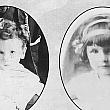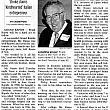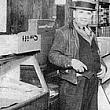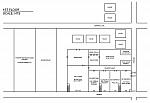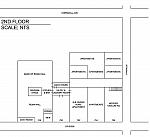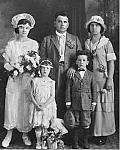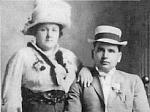
Loss of Russo Property
by Kim Rush, John Russo, and Martin Starr
It was late on Sunday evening, August 11, 1991, when a spokesperson for the Grand Rapids Police Department notified cousins John and Frank G. Russo that the roof had collapsed over a cluster of buildings and apartments that they owned. A windstorm had buckled its weakened roof and the front of the building was beginning to topple, as well. The structures were located on the northeast corner of Franklin and Division, S.E. A few policemen and Father Dennis Morrow, the priest at Our Lady of Sorrows church, spent part of the night and the following morning with John and Frank at the site. Morrow was a friend of the Russo family and also served as the chaplain for the Grand Rapids fire department. The police displayed concern that family members might try to enter the building to salvage items of value.
Eventually, everyone realized that the damage was so severe that the buildings could not be saved. John had known that the roof was leaking, but never imagined that it could lead to such a sudden and irreversible situation. Their buildings were officially condemned by 8:00 A.M. and wrecking crews began demolition shortly before noon. According to a July 6, 1951 city tax assessor report prepared by Harold Morrison, this structure, located at 746-748 Division Avenue S.E., was “very poorly constructed.”[1] Musician Doug Cook recalls how “the floor shook and sagged with the weight of the dancers” while he performed at the second story dance hall in this building.
.jpg) John Russo: “Most of the original decor from the buildings was retained through the years. Old heating units, restaurant fixtures, ornate metal ceilings from the stores, and oak pocket doors . . . all of these items were hauled away by salvage companies or brought to the dump during the demolition process. The Russo family was not allowed back into the property after the roof collapsed. It was simply too dangerous. It was like the sinking of the Titanic. Bricks were popping off from the upper walls down on to the sidewalks surrounding the corner building as well as on Franklin Street, which eventually had to be closed to traffic. Sparks were flying as the electricity was still running to the property. The main wires leading to the building had to be cut by Consumers Power. My cousin Frank and I scrambled to obtain a loan, paying $25,000 plus interest to tear down the entire corner. Nothing was preserved.”
John Russo: “Most of the original decor from the buildings was retained through the years. Old heating units, restaurant fixtures, ornate metal ceilings from the stores, and oak pocket doors . . . all of these items were hauled away by salvage companies or brought to the dump during the demolition process. The Russo family was not allowed back into the property after the roof collapsed. It was simply too dangerous. It was like the sinking of the Titanic. Bricks were popping off from the upper walls down on to the sidewalks surrounding the corner building as well as on Franklin Street, which eventually had to be closed to traffic. Sparks were flying as the electricity was still running to the property. The main wires leading to the building had to be cut by Consumers Power. My cousin Frank and I scrambled to obtain a loan, paying $25,000 plus interest to tear down the entire corner. Nothing was preserved.”
The Russo properties had been for sale for four years prior to their demolition. It was closed for business for the latter half of this duration as a result of failing to meet city codes. John and Frank had struggled to keep up with property taxes and maintain the properties. Meanwhile, they pursued grants and loans, intending to remodel the buildings, replace the roof, and ultimately revitalize business. The banks had redlined this area. Time ultimately ran out for them. Towards the end, homeless people broke into some of the units and dwelled there. John and Frank worried constantly about theft and other crimes occurring within their buildings, especially after John’s uncle, Tony Russo, was murdered at 17 Franklin S.E. Tony’s property was also part of the Russo family complex. He operated a barbershop and laundry here, living above the barber shop for 25 years. In 1960 he moved his business and home to another location. On June 24, 1975, while he was checking on his deserted building, he was overcome and strangled to death by two men in his vacated apartment.[2]
 John Russo: “The original Russo property was 746 thru 752 Division, which was all one building. We lived in the large apartments (752) and rented another large apartment (750) until the early 1960s. Eventually there were thirteen small apartments and four small free-standing houses within the complex on that corner. This included two houses located directly behind our building, on Cornwall, and two more on Franklin. The houses on Cornwall were small two-story houses that were actually shacks. They were torn down to make room for the expansion of a dance hall and to create a rear entry for the warehouse located below the hall. Some of these were moved and others were torn down.
John Russo: “The original Russo property was 746 thru 752 Division, which was all one building. We lived in the large apartments (752) and rented another large apartment (750) until the early 1960s. Eventually there were thirteen small apartments and four small free-standing houses within the complex on that corner. This included two houses located directly behind our building, on Cornwall, and two more on Franklin. The houses on Cornwall were small two-story houses that were actually shacks. They were torn down to make room for the expansion of a dance hall and to create a rear entry for the warehouse located below the hall. Some of these were moved and others were torn down.
 In the early 1900s, Mike Skaff's family owned the adjoining building, 754-756 Division, until Frank G. Russo’s father, Joe L. Russo, bought it around 1970. In other words, there were several buildings built next to each other and they became one property when Frank and I put it all into one corporation. There were many internal transactions involving my grandfather, my grandmother, my dad, and my aunts and uncles, as the family estate was divided over time. Frank and I bought out the various relatives' interests and united the whole corner under Lombardo Properties, Inc.” Over the life of the building, tenants such as Atlantic and Pacific grocery, a Chinese laundry, Bleimeyer’s 5 & 10, Jim’s Variety, a furniture store, a pool hall, Fletcher Drug Store, and Hoover Vacuum Cleaners, all operated businesses in these buildings.
In the early 1900s, Mike Skaff's family owned the adjoining building, 754-756 Division, until Frank G. Russo’s father, Joe L. Russo, bought it around 1970. In other words, there were several buildings built next to each other and they became one property when Frank and I put it all into one corporation. There were many internal transactions involving my grandfather, my grandmother, my dad, and my aunts and uncles, as the family estate was divided over time. Frank and I bought out the various relatives' interests and united the whole corner under Lombardo Properties, Inc.” Over the life of the building, tenants such as Atlantic and Pacific grocery, a Chinese laundry, Bleimeyer’s 5 & 10, Jim’s Variety, a furniture store, a pool hall, Fletcher Drug Store, and Hoover Vacuum Cleaners, all operated businesses in these buildings.
Credits:
The contents of this photo essay will beg for correction and will continue to develop as long as we live, and hopefully much longer. There were numerous people involved in assembling and documenting this data, and we are all still interested in learning more. John Russo and Martin Starr could have easily written this type of piece, as they know the story line far better than I ever will. Yet I was fortunate enough to attempt this account, although from a relatively uninformed point of view. Gratefully, I could always depend on John’s constant assistance, from the beginning to the end.
Credit for providing source information and checking the credibility of my data is due to the grandson of G.B. Russo, John Russo, of Grand Rapids, Michigan. His interest and enthusiasm pertaining to the topic of Russo family history is relentless. Equally persistent is his patience with my endless questions about Roma Hall and Russo family history. Thank you so very much, John!
I’d also like to express deep gratitude to Martin Starr, a Russo family historian and genealogist, for his tireless assistance with providing historic family related documents and answering questions about the Russo family as well as Sicilian history.
G.B. Russo’s daughter Jennie Russo Moschetti, Frank D. Russo, and Paul Russo also provided indispensable information for this article.
A generous portion of G.B. Russo family history information was obtained from an unpublished document compiled by Jennie Russo Moschetti, Mary C. Russo, John Russo, and Frank D. Russo.
Kim Rush
[1] Grand Rapids city tax assessor report composed on 7.6 1951 by Harold Morrison. Grand Rapids City Archives
[2] Grand Rapids Press, 6.25. 1975. “Landlord Retiree 75, is Strangled”

 facebook
facebook